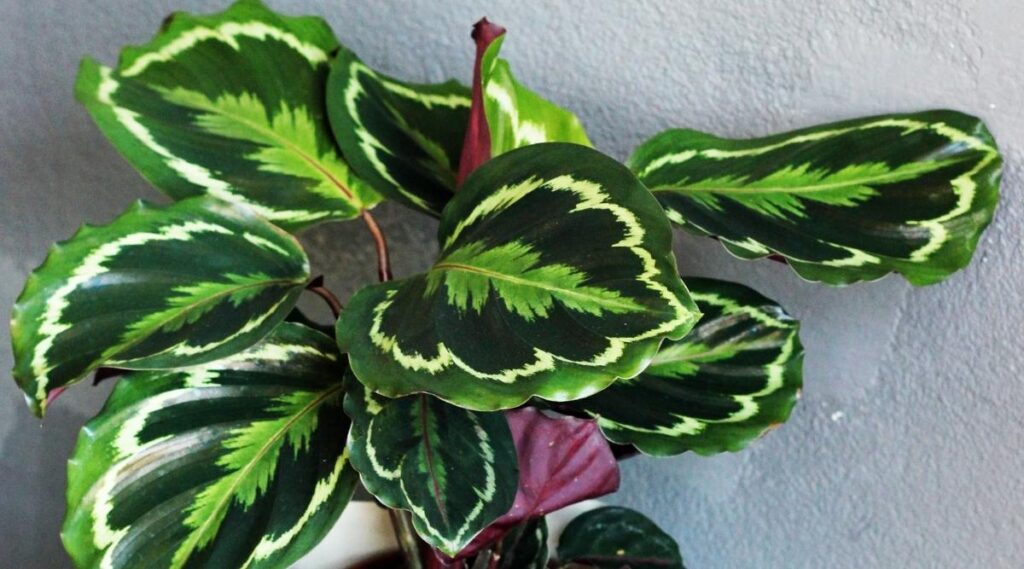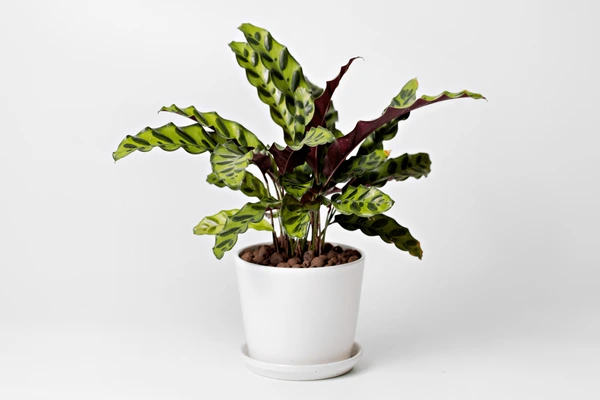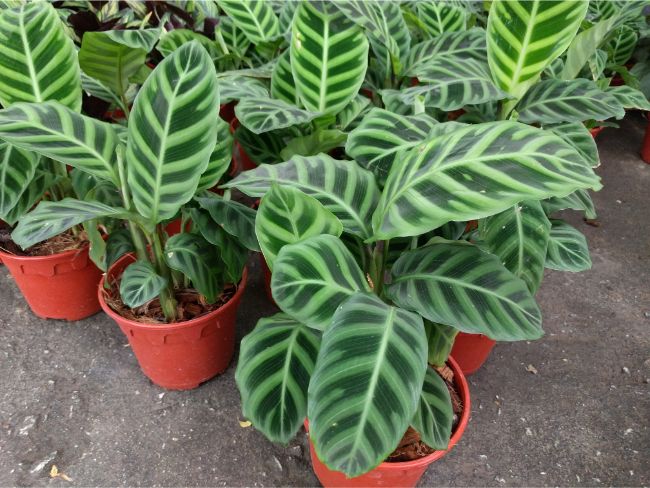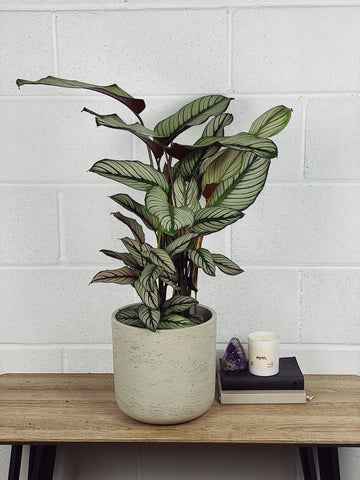Calatheas, better known as ‘prayer plants,’ are all members of the genus Maranta, to which genus Calathea is closely-related. They also have a special quality, known as nyctinasty, their sensitive leaves move in reaction to the light they receive.
In the evening, they turn their leaves up, and during daylight hours, they lower them in a beautiful Calathea sun salutation. This behavior is why they’re lovingly referred to as Prayer Plants.
Calathea plant most common species or cultivars are Calathea veitchiana ‘Medallion’ (Medallion calathea) and Calathea lancifolia (Rattlesnake calathea).
1. Calathea veitchiana (Medallion calathea)
Its variegated leaves make it a lovely addition to any home.

.
2.Calathea lancifolia (Rattlesnake calathea).
Its bright green, wavy leaves are striped with alternating ovals of dark green and accented by a rich purple underside.
The plant gets its name from its lance-shaped foliage, and the leaves grow more elongated as the plant matures.

3.Calathea Zebrina
The striking light green and velvety leaves with purple undersides earn their common name due to the dark green stripes running across them resembling a Zebra.

4.Calathea warscewiczii (Jungle Velvet)
The broad, dark green foliage sports attractive light green to white streaks radiating from the middle of each leaf. Underneath, the foliage is a vibrant purple, earning them the common nickname of Jungle Velvet.

5. Calathea majestica (White star)
The Calathea Majestica Whitestar is native to the tropical rainforests of Brazil. This specimen is known to be a cultivar of the ornata species and sports several bright white stripes from the midrib of the plant extending to its leaf blades.
Some of the leaves may feature pink shades near the midrib, depending on the light conditions and maturity of the plant.
White star plant has more stripes that almost fill the whole leaf and can grow as high as 4 to 5ft in large pots and the leaves can become very long.

Here are tips for caring for a prayer plant, whether grown indoors or outdoors.
1. Don’t overwater. While prayer plants like their soil moist, don’t overwater them. Water during the growing season when the top of the soil becomes dry, and don’t let the soil completely dry out.
Overwatering can cause the leaf tips to yellow and fall off, as well as lead to root rot and fungal problems. Additionally, never water with cold water. Tap water usually works just fine.
2. Fertilize regularly. Every two weeks or so during the growing season (typically late spring to early fall), fertilize your prayer plant with a water-soluble houseplant fertilizer.
The plant needs fertilizer only about once a month in the winter. Keep in mind that too much fertilizer can cause brown leaves or even possibly the death of the plant, so you may want to dilute the fertilizer to half strength.
3. Soil. Regular potting soil usually works just fine for prayer plants, but make sure the pot has drainage holes and the potting mix is airy and well-draining.
To make your own ideal soil for a prayer plant, combine peat moss, perlite loam soil and coarse sand. Note that too much perlite could result in fluoride burn, which can lead to browning leaves.
4. Keep the air humid. Outside of its native growing areas and hardiness zones, prayer plants might require a humidifier to keep the indoor growing area moist. An environment that’s too dry can cause brown tips on the leaves. Bathrooms are good spots for prayer plants because they are naturally more humid than the rest of a home. Grooming or dusting with wet piece of cloth is also recommended.
5.Repotting is necessary when the roots of the prayer plant start to grow out of the drainage holes in its pot. Additionally, if the plant stops growing or needs constant watering to keep the soil moist, it’s time to repot. However, prayer plants like being somewhat rootbound, so you shouldn’t need to move them often.
6. Sunlight. Prayer plants prefer indirect sunlight as opposed to direct sunlight and thrive in shady but warm areas. Since t.hey are native to rainforests, you should provide the plants with lower light, controlled by either location or some type of cover.
However, the leaves won’t fully open during the day if they don’t receive enough light, so don’t place them in completely dark areas, either.
If the plant’s leaves fade in color, it’s a sign the plant is receiving too much sun.
7. Propagation. To capitalize on a healthy prayer plant, create multiple plants by propagating the original.
You can propagate prayer plants by dividing the whole plant or taking stem cuttings.
When it’s time to repot the prayer plant, pull a section of the plant away, gently separate the roots, and then plant the new plant in its own pot.
For stem cuttings, cut the stem below the leaf and place it in a glass of water. Replace the water every few days until new roots develop.
8. Pests and diseases. With prayer plants, you want to watch out for mealybugs and spider mites.
Treat an infestation by spraying the plant lightly with neem oil.
Fungal disease is the most common affliction in prayer plants because of the moist soil and humid environment. To prevent issues, use well-draining soil, avoid overwatering, and keep the prayer plant’s leaves out of standing water.